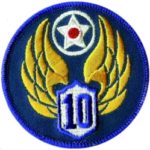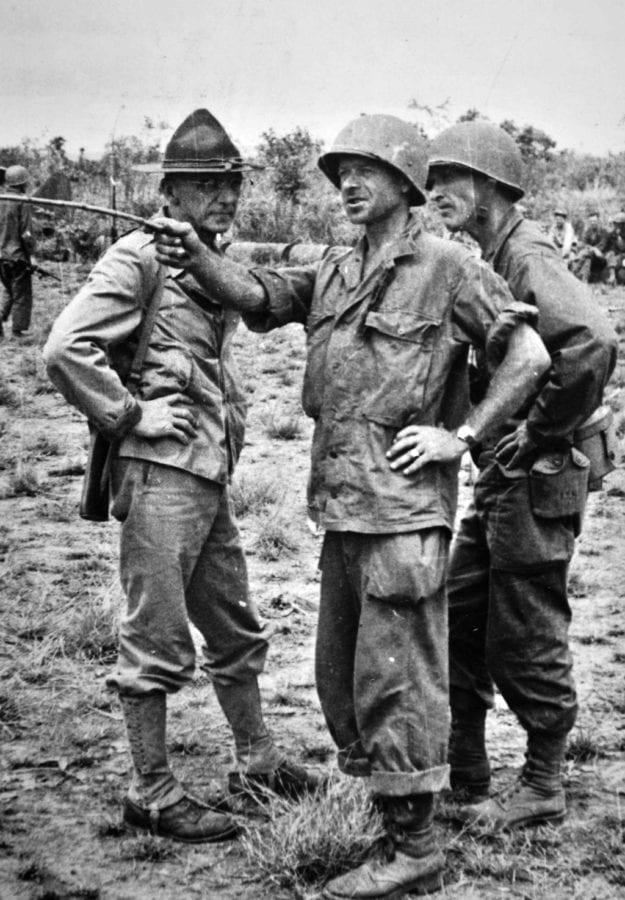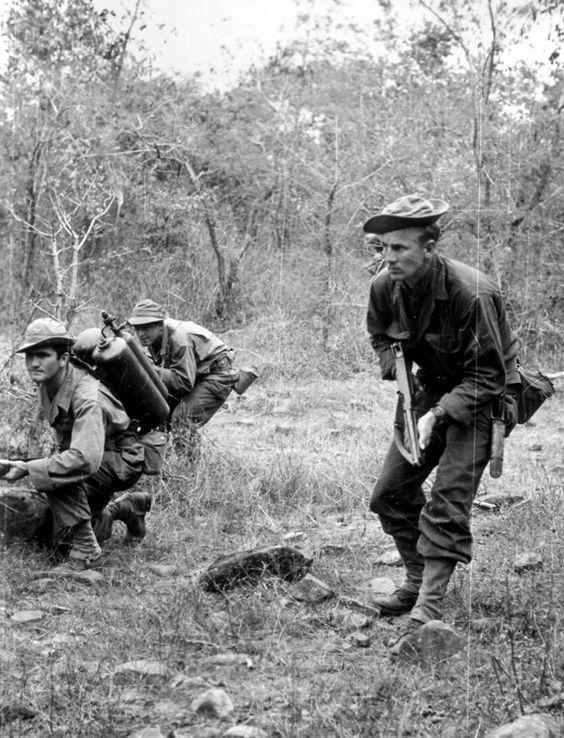From Defense to Offense
The strategic situation in Burma began to change in the spring of 1943 when the Allies assumed the offensive with an experimental operation behind the enemy lines. This operation, foreshadowing the part the Marauders were to take in the larger offensive of 1944, was an expedition commanded by Gen Orde C. Wingate, who led the Long Range Penetration Group (LRPGs) of the 77th Indian Infantry Brigade across the natural barrier between India and Burma into Japanese-held territory. Wingate’s forces consisted of eight jungle columns totaling 3200 men, assembled from British, Indian, Burmese, and Gurkha troops. Directed, by radio and supplied by airdrops, in a period of 4 months (Feb to Jun 1943) his columns covered a distance of 1000 miles.
In the area of northern Burma, from the Chindwin River eastward to China, they gathered topographical and other intelligence, harassed and confused the Japanese forces, and cut enemy lines of communication. The columns put the Mandalay-Myitkyina railway out of action for 4 weeks and engrossed the efforts of six to eight enemy battalions. When ordered to return, the columns dispersed in small groups, each of which successfully fought its own way out of Burma.
After this first penetration, the seasonal rains again restricted ground activity. However, Allied bombers of the 10-USAAF continued their attacks on Japanese supply lines in both Burma and Thailand with steadily increasing strength.

 Gen George E. Stratemeyer’s force had established definite superiority over Burma by Nov 1943, the beginning of the dry season during which a ground offensive was possible. At this time many indications pointed to a resumption of the Japanese offensive against India. Since the fall of 1942, the enemy had brought two more divisions into the area, making a total of five distributed along the India border. The one division (55th) on the front beyond Akyab was extremely aggressive. In the Chin Hills, three others (the 15th, 31st, and 33d) were organizing for a strong offensive into Manipur Province.
Gen George E. Stratemeyer’s force had established definite superiority over Burma by Nov 1943, the beginning of the dry season during which a ground offensive was possible. At this time many indications pointed to a resumption of the Japanese offensive against India. Since the fall of 1942, the enemy had brought two more divisions into the area, making a total of five distributed along the India border. The one division (55th) on the front beyond Akyab was extremely aggressive. In the Chin Hills, three others (the 15th, 31st, and 33d) were organizing for a strong offensive into Manipur Province.
The 18th Division, in northern Burma, was ready to oppose any advance from Assam. The Allies, too, were preparing for major offensive operations from both India and China. Adm Louis Mountbatten, commander in Southeast Asia, was assembling troops and supplies in Bengal and Manipur. Generalissimo Chiang Kai-Shek was strengthening his forces along the Salween River in Yunnan. The first Allied blow was to come from the north, led by Gen Stilwell, Deputy Commander in the Southeast Asia Command and Chief of Staff for Allied operations in the Chinese Theater. Operating from bases in the upper Brahmaputra Valley, Gen Stilwell had mounted an offensive to carry over the Patkai Range, conquer northern Burma, and open a new land route to China. American-trained Chinese divisions constituted his main striking force. In immediate support of his advance, Long Range Penetration Operations were to be carried out by combat teams of the 5307 Galahad under Gen Frank Merrill.
By February, when the 5307 arrived in the area of operations, Gen Stilwell’s offensive had made good progress. The Chinese 22d and 38th Divisions had crossed the Patkai barrier and were engaging the Japanese forces in the flood plains of the Hukawng Valley. Covered by this advance, United States engineers had pushed a road over the Patkais to Shingbwiyang, 100 miles from the starting base at Ledo. However, the main enemy resistance and strongest prepared positions were still to be met. Secondary Allied operations had been planned to support the main drive into north Burma. Gen Wingate’s jungle columns of the 3rd Indian Division were ready to thrust into central Burma, with the aim of cutting enemy communications far south of Gen Stilwell’s objectives. On the Irrawaddy headwaters in northeast Burma, the Allies had a base at Fort Hertz, in wild country which the Japanese had never been able to conquer. Here, Gurkha and Kachin levies from the native tribes were harassing Japanese outposts in the Sumprabum – Myitkyina corridor.
Origin and Training of the American Force
The 5307 Composite Unit (Provisional) was organized to participate in the Burma operations as the result of a decision made at the Quebec Conference in Aug 1943. Five months later, on Feb 1, 1944, the three battalions comprising the provisional unit had been transported to India, organized, trained, and equipped for employment. They were the only American ground combat troops designated at this time for the China-Burma-India Theater. On Sep 1, 1943, when the size of the battalions had been fixed at 1000, the War Department began recruiting personnel from jungle-trained and jungle-tested troops, primarily infantrymen. Gen George C. Marshall requested 300 volunteers of a high state of physical ruggedness and stamina from the Southwest Pacific, 700 from the South Pacific, and 1000 each from the Caribbean Defense Command and the Army Ground Forces in the United States.
In answer to Gen Marshall’s request, the South and Southwest Pacific Commands selected 950 men from veterans of Guadalcanal, New Guinea, and other operations in those theaters. The Caribbean Defense Command secured 950 more troops who had served on Trinidad and Puerto Rico, and a similar number came from highly-trained units within the United States. The Caribbean volunteers flew to Miami, crossed the continent by rail, and assembled in San Francisco with the volunteers from the States. These men formed two battalions; the third from the South and Southwest Pacific areas was to join the force on the way to Bombay.
 Col Charles N. Hunter, the senior officer among the volunteers, was appointed commander of the battalions. He was ordered to prepare the men while en route for the performance of their mission, to keep Gen Stilwell informed of the progress of the movement, and to report to the General upon arrival in the theater. On Sep 21, the two battalions sailed from San Francisco on the Lurline. As much of their equipment as could be loaded aboard went with them; the remainder was sent to San Diego, and from there it was to be forwarded in one shipment to Bombay. The Lurline proceeded to Noumea, New Caledonia, where 650 officers and men from the South Pacific Theater came aboard.
Col Charles N. Hunter, the senior officer among the volunteers, was appointed commander of the battalions. He was ordered to prepare the men while en route for the performance of their mission, to keep Gen Stilwell informed of the progress of the movement, and to report to the General upon arrival in the theater. On Sep 21, the two battalions sailed from San Francisco on the Lurline. As much of their equipment as could be loaded aboard went with them; the remainder was sent to San Diego, and from there it was to be forwarded in one shipment to Bombay. The Lurline proceeded to Noumea, New Caledonia, where 650 officers and men from the South Pacific Theater came aboard.
The contingent from the Southwest Pacific joined the ship at Brisbane, Australia. After a brief stop at Perth, the Lurline steamed across the Indian Ocean and up the Arabian Sea to Bombay, where the three battalions disembarked by Oct 31. Organizing and training of the 5307 began immediately. Col Francis G. Brink, selected because he had trained Chinese troops in India, instructed the unit in long-range-penetration tactics. After meeting the Lurline at Bombay, he accompanied the troops to a British camp at Deolali and 3 weeks later moved with them to Deogarh, close to an area suitable for jungle training.
From the end of Nov 1943 to the end of Jan 1944, the 5307 remained at Deogarh and trained intensively. On the advice of Gen Wingate who supervised the over-all preparation of the unit, each battalion was formed into two jungle columns, called combat teams by the Americans. These units were not combat teams in the accepted American sense, for their organization represented only a division of each battalion into two smaller units, without any addition of elements not organic to the battalion. The division was made in such a manner that each combat team had its share of the heavy weapons and other organic battalion elements and thus was able to operate as a self-contained unit. Col William L. Osborne was assigned command of the 1/5307 (two combat teams, Red and White) placed under Maj Edward M. Ghiz and Maj Caifson Johnson, respectively. Col George A. McGee became commanding officer of the 2/5307 (two combat teams, Blue Combat Team under Maj Richard W. Healy and Green Combat Team under Capt Thomas E. Bogardus. The 3/5307 was placed under command of Col Charles E. Beach (two combat teams, Orange Combat Team under Maj Lawrence L. Lew and Khaki Combat Team under Maj Edwin J. Briggs.
Col Charles N. Hunter
Second in Command
5307th Composite Unit (Provisional)


















